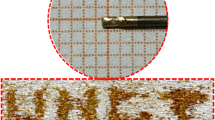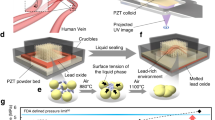Abstract
High-frequency ultrasonic transducers have been implemented as a powerful tool for modern medical diagnosis and therapy. Most current transducers use piezoelectric ceramics for electromechanical couplings, which will undergo periodic electro-acoustic transitions at high frequencies (≥20 MHz), thereby requiring high reliability. This work presents a structural engineering strategy to improve the piezoelectricity and reliability of potassium sodium niobate (KNN)-based ceramics with potential high-frequency ultrasonic imaging transducers. The KNN-based ceramics exhibit fatigue-free behavior with enhanced piezoelectricity (d33 ∼550 ± 20 pC N−1), and the mechanisms are discussed in view of multi-dimensions from macroscopy to microscopy. Considering the synergistic effect of multi-phase coexistence, well-kept microstructure, and flexible domain rotation, property-worsening cracks during fatigue are restrained; furthermore, the aggregation of space charges is hindered, thereby reducing the pinned domain and improving the fatigue resistance. Based on the high-performance piezoceramics, the fabricated ultrasonic transducer has high reliability with a steady sensitivity and an unchanged broad bandwidth (∼76%) from room temperature to 80°C. In addition, images of a tilapia eyeball are scanned to confirm the imaging capability of transducers. We expect that the novel approach to achieving high performance through the structural strategy promotes KNN-based ultrasonic devices for biomedical imaging.

摘要
高频超声换能器已成为现代医学诊断和治疗的有力工具. 目前,大多数超声换能器使用压电陶瓷进行机电耦合, 在高频(>20 MHz)下会发生周期性的电声转换, 因此对材料可靠性要求较高. 本文提出了一种结构调控策略, 以提高铌酸钾钠(KNN)基无铅陶瓷的压电性与可靠性,并用于高频超声成像. 该KNN基陶瓷具有增**的压电性(d33 ~550 ±20 pC N−1)及抗疲劳特性, 同时针对其良好性能, 我们从涉及宏观到微观的多项共存、完好微观结构与灵活畴翻转的多维度协同效应阐述其机理. 该多维度协同效应抑制了疲劳过程中性能恶化裂纹的出现及空间电荷的聚集, 从而减少了畴壁的钉扎, 增**了抗疲劳性. 此外, 基于该高性能压电陶瓷制备的超声换能器具有高可靠性及温度稳定性(从室温到80°C, 频带宽度几乎不变). 我们利用该超声换能器扫描罗非鱼眼球结构测试了器件成像效果. 相信通过结构策略实现性能提升的新方法可以促进KNN基超声器件在生物医学方面的应用.
Similar content being viewed by others
References
Hu H, Zhu X, Wang C, et al. Stretchable ultrasonic transducer arrays for three-dimensional imaging on complex surfaces. Sci Adv, 2018, 4: eaar3979
Shung KK. Diagnostic Ultrasound: Imaging and Blood Flow Measurements. Second edition. Boca Raton: CRC Press, 2015
Zhang S, Li F, Jiang X, et al. Advantages and challenges of relaxor-PbTiO3 ferroelectric crystals for electroacoustic transducers—A review. Prog Mater Sci, 2015, 68: 1–66
Zhou Q, Lam KH, Zheng H, et al. Piezoelectric single crystal ultrasonic transducers for biomedical applications. Prog Mater Sci, 2014, 66: 87–111
Zhou Q, Lau S, Wu D, et al. Piezoelectric films for high frequency ultrasonic transducers in biomedical applications. Prog Mater Sci, 2011, 56: 139–174
Wu J, **ao D, Zhu J. Potassium-sodium niobate lead-free piezoelectric materials: Past, present, and future of phase boundaries. Chem Rev, 2015, 115: 2559–2595
Hejazi MM, Jadidian B, Safari A. Fabrication and evaluation of a single-element Bi0.5Na0.5TiO3-based ultrasonic transducer. IEEE Trans Ultrason Ferroelect Freq Contr, 2012, 59: 1840–1847
Lee STF, Lam KH, Zhang XM, et al. High-frequency ultrasonic transducer based on lead-free BSZT piezoceramics Ultrasonics, 2011, 51: 811–814
Chen R, Jiang L, Zhang T, et al. Eco-friendly highly sensitive transducers based on a new KNN-NTK-FM lead-free piezoelectric ceramic for high-frequency biomedical ultrasonic imaging applications IEEE Trans Biomed Eng, 2019, 66: 1580–1587
Zeng Y, Jiang L, Sun Y, et al. 3D-printing piezoelectric composite with honeycomb structure for ultrasonic devices Micromachines, 2020, 11: 713
Zhao C, Wu H, Li F, et al. Practical high piezoelectricity in barium titanate ceramics utilizing multiphase convergence with broad structural flexibility. J Am Chem Soc, 2018, 140: 15252–15260
Bai W, Li L, Wang W, et al. Phase diagram and electrostrictive effect in BNT-based ceramics. Solid State Commun, 2015, 206: 22–25
Zheng T, Zhang Y, Ke Q, et al. High-performance potassium sodium niobate piezoceramics for ultrasonic transducer. Nano Energy, 2020, 70: 104559
Jiang L, Yang Y, Chen R, et al. Ultrasound-induced wireless energy harvesting for potential retinal electrical stimulation application. Adv Funct Mater, 2019, 29: 1902522
Saito Y, Takao H, Tani T, et al. Lead-free piezoceramics. Nature, 2004, 432: 84–87
Xu K, Li J, Lv X, et al. Superior piezoelectric properties in potassium-sodium niobate lead-free ceramics. Adv Mater, 2016, 28: 8519–8523
Tao H, Wu H, Liu Y, et al. Ultrahigh performance in lead-free piezoceramics utilizing a relaxor slush polar state with multiphase coexistence. J Am Chem Soc, 2019, 141: 13987–13994
Li P, Zhai J, Shen B, et al. Ultrahigh piezoelectric properties in textured (K,Na)NbO3-based lead-free ceramics. Adv Mater, 2018, 30: 1705171
Lv X, Wu J. Effects of a phase engineering strategy on the strain properties in KNN-based ceramics. J Mater Chem C, 2019, 7: 2037–2048
Cen Z, Dong Z, Xu Z, et al. Improving fatigue properties, temperature stability and piezoelectric properties of KNN-based ceramics via sintering in reducing atmosphere. J Eur Ceramic Soc, 2021, 41: 4462–4472
Zhao Y, Du J, Xu Z, et al. Domain evolution and corresponding piezoelectricity of lead-free In2O3-doped K0.5Na0.5NbO3 ceramics together with improved fatigue resistance and temperature stability. Mater Sci Eng-B, 2019, 243: 141–148
Zhang S, **a R, Hao H, et al. Mitigation of thermal and fatigue behavior in K0.5Na0.5NbO3-based lead free piezoceramics. Appl Phys Lett, 2008, 92: 152904
Hao J, Xu Z, Chu R, et al. Good temperature stability and fatigue-free behavior in Sm2O3-modified 0.948(K0.5Na0.5)NbO3-0.052LiSbO3 lead-free piezoelectric ceramics. Mater Res Bull, 2015, 65: 94–102
Yao FZ, Patterson EA, Wang K, et al. Enhanced bipolar fatigue resistance in CaZrO3-modified (K,Na)NbO3 lead-free piezoceramics. Appl Phys Lett, 2014, 104: 242912
Tao H, Yin J, Zhao C, et al. Relaxor behavior of potassium sodium niobate ceramics by domain evolution. J Eur Ceramic Soc, 2021, 41: 335–343
Damjanovic D. Contributions to the piezoelectric effect in ferroelectric single crystals and ceramics. J Am Ceramic Soc, 2005, 88: 2663–2676
Sun X, Li R, Yang Z, et al. Modulating polarization rotation to stimulate the high piezocatalytic activity of (K,Na)NbO3 lead-free piezoelectric materials. Appl Catal B-Environ, 2022, 313: 121471
Guo R, Cross LE, Park SE, et al. Origin of the high piezoelectric response in PbZr1−xTixO3. Phys Rev Lett, 2000, 84: 5423–5426
Yao FZ, Wang K, Jo W, et al. Diffused phase transition boosts thermal stability of high-performance lead-free piezoelectrics. Adv Funct Mater, 2016, 26: 1217–1224
Du H, Li Z, Tang F, et al. Preparation and piezoelectric properties of (K0.5Na0.5)NbO3 lead-free piezoelectric ceramics with pressure-less sintering. Mater Sci Eng-B, 2006, 131: 83–87
Li BZ, Blendell JE, Bowman KJ. Temperature-dependent poling behavior of lead-free BZT-BCT piezoelectrics J Am Ceram Soc, 2011, 94: 3192–3194
Glaum J, Hoffman M. Electric fatigue of lead-free piezoelectric materials J Am Ceram Soc, 2014, 97:665–680
Yao FZ, Glaum J, Wang K, et al. Fatigue-free unipolar strain behavior in CaZrO3 and MnO2 co-modified (K,Na)NbO3-based lead-free piezoceramics Appl Phys Lett, 2013, 103: 192907
Huang Q, Chen Z, Cabral MJ, et al. Direct observation of nanoscale dynamics of ferroelectric degradation. Nat Commun, 2021, 12: 2095
Yao FZ, Wang K, Cheng LQ, et al. Nanodomain engineered (K,Na)NbO3 lead-free piezoceramics: Enhanced thermal and cycling reliabilities. J Am Ceram Soc, 2015, 9: 448–454
Yang SM, Kim TH, Yoon JG, et al. Nanoscale observation of time-dependent domain wall pinning as the origin of polarization fatigue. Adv Funct Mater, 2012, 22: 2310–2317
Balke N, Lupascu DC, Granzow T, et al. Fatigue of lead zirconate titanate ceramics. I: Unipolar and DC loading. J Am Ceramic Soc, 2007, 90: 1081–1087
Jiang L, Chen R, **ng J, et al. Fabrication of a (K,Na)NbO3-based lead-free 1–3 piezocomposite for high-sensitivity ultrasonic transducers application. J Appl Phys, 2019, 125: 214501
Acknowledgements
This work was supported by the National Natural Science Foundation of China (NSFC 52202144, 52061130216 and 52032007), the Key-Area Research and Development Program of Guangdong Province (2020B0109380001), the Central Funds Guiding the Local Science and Technology Development of Sichuan Province (2021ZYD0022), and the Fundamental Research Funds for the Central Universities, Sichuan University (YJ2021153). Wu J thanks the Newton Advanced Fellowship award (NAFR1201126) from the Royal Society. The authors thank Mrs. Hui Wang (Analytical & Testing Center of Sichuan University) for collecting the FE-SEM images.
Author information
Authors and Affiliations
Contributions
Jiang L and Wu J conceived the idea of this work. Li R and Sun XX conceived and designed the experiments. Sun XX and Li C helped construct the framework of the manuscript. Jiang L and Zeng Y prepared the KNN-based transducer. Zeng Y and Li R used the UBM to scan the images of tilapia eyeballs. Jiang L, Zheng T, and Wu J helped modify the manuscript.
Corresponding authors
Additional information
Conflict of interest
The authors declare that they have no conflict of interest.
Supplementary information
Supporting data are available in the online version of the paper.
Ruichen Li is currently pursuing a PhD degree in the College of Materials Science and Engineering at Sichuan University. He received his bachelor’s degree in materials physics and chemistry from Sichuan University in 2018. His research interests mainly focus on KNN-based piezoceramics, ferroelectric materials, and high-frequency ultrasound transducers.
Yushun Zeng (graduate student member, IEEE) received the BS degree in bioengineering from Nan**g Tech University, Nan**g, China, in 2019, and MS degree in biomedical engineering from the University of Southern California, Los Angeles, CA, USA, in 2021. He is currently pursuing a PhD degree from the Department of Biomedical Engineering, University of Southern California, Los Angeles, CA, USA. His research interests mainly focus on the high-frequency ultrasound transducer/array, 3D-printed ultrasonic device, and acoustic tweezer.
Laiming Jiang is an assistant professor in the College of Materials Science and Engineering at Sichuan University. He received his PhD degree in materials physics and chemistry from Sichuan University in 2019. He worked as a postdoctoral scholar-research associate at the Keck School of Medicine, the University of Southern California in 2020–2021. His research work focuses on the development of high-performance piezoelectric materials, piezoelectric ultrasound transducers, ultrasound-induced energy harvesting, multiscale and multi-materials 3D printing, and bio-implantable devices.
Jiagang Wu has been a fulltime professor at Sichuan University since 2015. He received his BS and PhD degrees in materials physics and chemistry from Sichuan University in 2003 and 2008, respectively. Then, he worked in Prof. John Wang’s group (Department of Materials Science and Engineering, National University of Singapore) as a Singapore Millennium Postdoctoral Fellow (SMF-PDF) from 2008 to 2010. His research interest mainly concentrates on the relationship of “structure-composition design-property modification” in ferro/piezoelectric/multiferroic materials, especially in lead-free piezoceramics.
Supporting Information
40843_2022_2184_MOESM1_ESM.pdf
Multidimensional synergy-induced high piezoelectricity and reliability KNN piezoceramics for high-frequency ultrasonic transducers
Rights and permissions
About this article
Cite this article
Li, R., Zeng, Y., Sun, Xx. et al. Multidimensional synergy-induced high piezoelectricity and reliability KNN piezoceramics for high-frequency ultrasonic transducers. Sci. China Mater. 66, 686–695 (2023). https://doi.org/10.1007/s40843-022-2184-7
Received:
Accepted:
Published:
Issue Date:
DOI: https://doi.org/10.1007/s40843-022-2184-7




